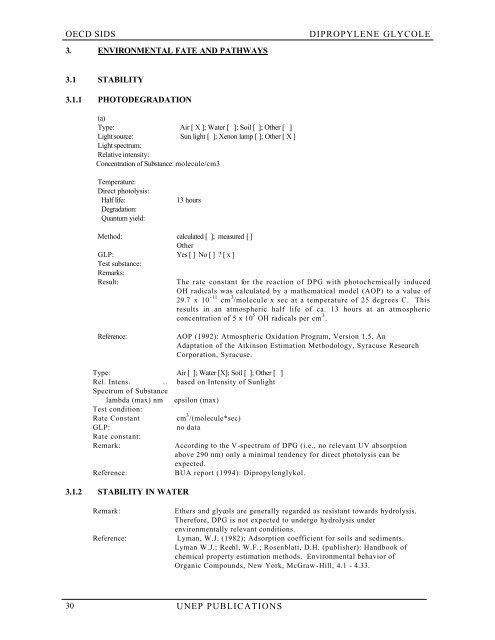Dipropylene glycol (SIDS)
Dipropylene glycol (SIDS)
Dipropylene glycol (SIDS)
Create successful ePaper yourself
Turn your PDF publications into a flip-book with our unique Google optimized e-Paper software.
OECD <strong>SIDS</strong><br />
3. ENVIRONMENTAL FATE AND PATHWAYS<br />
DIPROPYLENE GLYCOLE<br />
3.1 STABILITY<br />
3.1.1 PHOTODEGRADATION<br />
(a)<br />
Type: Air [ X ]; Water [ ]; Soil [ ]; Other [ ]<br />
Light source: Sun light [ ]; Xenon lamp [ ]; Other [ X ]<br />
Light spectrum:<br />
Relative intensity:<br />
Concentration of Substance: molecule/cm3<br />
Temperature:<br />
Direct photolysis:<br />
Half life:<br />
Degradation:<br />
Quantum yield:<br />
13 hours<br />
Method: calculated [ ]; measured [ ]<br />
Other<br />
GLP: Yes [ ] No [ ] ? [ x ]<br />
Test substance:<br />
Remarks:<br />
Result:<br />
The rate constant for the reaction of DPG with photochemically induced<br />
OH radicals was calculated by a mathematical model (AOP) to a value of<br />
29.7 x 10 -11 cm 3 /molecule x sec at a temperature of 25 degrees C. This<br />
results in an atmospheric half life of ca. 13 hours at an atmospheric<br />
concentration of 5 x 10 5 OH radicals per cm 3 .<br />
Reference:<br />
AOP (1992): Atmospheric Oxidation Program, Version 1.5. An<br />
Adaptation of the Atkinson Estimation Methodology, Syracuse Research<br />
Corporation, Syracuse.<br />
Type: Air [ ]; Water [X]; Soil [ ]; Other [ ]<br />
Rel. Intens. .. based on Intensity of Sunlight<br />
Spectrum of Substance<br />
lambda (max) nm epsilon (max)<br />
Test condition:<br />
Rate Constant cm 3 /(molecule*sec)<br />
GLP: no data<br />
Rate constant:<br />
Remark:<br />
Reference:<br />
3.1.2 STABILITY IN WATER<br />
According to the V-spectrum of DPG (i.e., no relevant UV absorption<br />
above 290 nm) only a minimal tendency for direct photolysis can be<br />
expected.<br />
BUA report (1994): Dipropylenglykol.<br />
Remark:<br />
Ethers and <strong>glycol</strong>s are generally regarded as resistant towards hydrolysis.<br />
Therefore, DPG is not expected to undergo hydrolysis under<br />
environmentally relevant conditions.<br />
Reference: Lyman, W.J. (1982); Adsorption coefficient for soils and sediments.<br />
Lyman W.J.; Reehl, W.F.; Rosenblatt, D.H. (publisher): Handbook of<br />
chemical property estimation methods. Environmental behavior of<br />
Organic Compounds, New York, McGraw-Hill, 4.1 - 4.33.<br />
30<br />
UNEP PUBLICATIONS
















